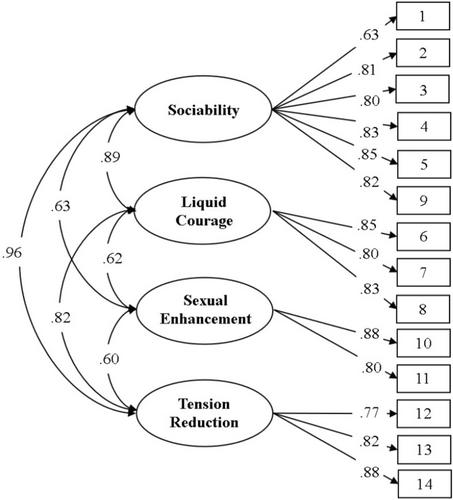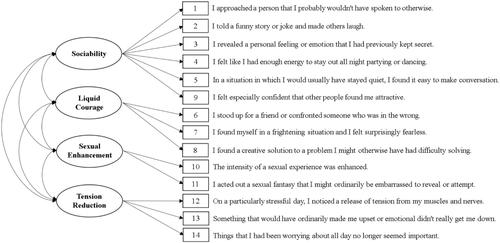The Positive Drinking Consequences Questionnaire (PDCQ) was developed to measure positive consequences of alcohol use endorsed by college drinkers. Efforts to assess positive drinking consequences experienced by adolescents have been much more limited. The aim of the present study was to advance the psychometric testing and evaluation of the factor structure of the PDCQ in adolescents.
The current sample consisted of 173 adolescents at T1 (mean age = 15 years, range = 13–17; 61% female) who reported alcohol use in the past 12 months. Data were collected at two time points over a 12-month interval in the United States. Confirmatory factor analyses, internal consistency, test–retest reliability, and discriminant, concurrent, predictive, and incremental validity were tested.
Our analyses supported four factors of positive alcohol-related consequences: sociability, liquid courage, sexual enhancement, and tension reduction. Internal consistency was moderate to high (α = 0.78–0.94, ω = 0.86–0.91 at T1; α = 0.59–0.93, ω = 0.85–0.93 at T2). Test–retest reliability was fair to good (ICC = 0.46–0.55). The PDCQ total and subscale factor scores demonstrated discriminant validity from negative alcohol expectancy. PDCQ total and subscale factor scores were positively associated with current alcohol consumption (ρs = 0.19–0.50 at T1; ρs = 0.17–0.46 at T2), indicating concurrent validity. Predictive validity analyses showed that the overall PDCQ scale score and the sociability subscale positively predicted maximum drinks 1 year later (ρs = 0.18–0.22). However, the sexual enhancement subscale was negatively predictive of typical drinking frequency 1 year later. Finally, the PDCQ showed incremental validity for concurrent alcohol consumption beyond that for alcohol expectancies and drinking motives.
The present findings support for the reliability and validity of PDCQ for use in adolescents where it may have utility as an assessment tool for characterizing various aspects of positive drinking.



